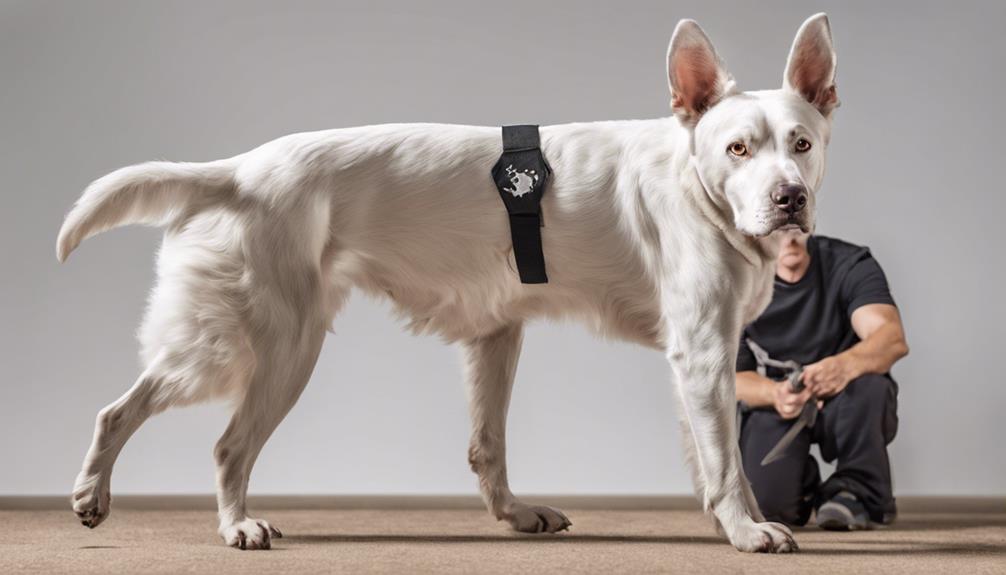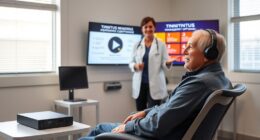Were you aware that over 5% of the global population, which equates to around 466 million people, suffer from disabling hearing loss? Navigating resources and support for an autonomous and enriched life can pose significant difficulties for those who are deaf. This is the juncture at which the Deaf Independent Living Association (DILA) comes into play, offering an array of services and initiatives tailored to uplift the deaf community and encourage self-reliance.
Key Takeaways:
- DILA offers a comprehensive range of services and programs for deaf individuals.
- They provide residential, community, and employment support services to empower the deaf community.
- DILA’s specialized programs teach essential skills in finance, housing, communication, and daily living activities.
- The Deaf Independent Residences (DIR) offer specially designed housing for deaf and hard-of-hearing individuals.
- DILA’s goal is to expand community awareness about Deaf culture and promote independent living for the deaf community.
Programs and Services offered by DILA
Deaf Independent Living Association (DILA) is a deaf advocacy organization that dedicates its efforts to empowering deaf individuals and enhancing their quality of life. DILA offers a comprehensive range of programs and services designed to meet the unique needs of the deaf and hard-of-hearing community.
Residential Support
DILA understands the importance of deaf-friendly accommodations for individuals seeking independence. That’s why they provide residential support through the Deaf Independent Residences (DIR). These specially designed houses offer a supportive living environment for deaf and hard-of-hearing individuals who want to live independently. Each house is equipped with deaf-friendly accommodations, ensuring a comfortable and inclusive living experience.
Community Support
DILA believes in fostering a strong deaf community and provides various community support services. They offer specialized programs that teach essential skills in finance, housing, communication, transportation, and more. These programs aim to enhance the independence and self-sufficiency of deaf individuals, empowering them to navigate the world with confidence.
Employment Support
In addition to residential and community support, DILA also offers employment support services. They assist deaf individuals in finding deaf-friendly workplaces and provide resources for job training and career development. DILA understands the importance of economic empowerment and strives to create equal employment opportunities for the deaf community.
| Programs and Services | Description |
|---|---|
| Residential Support | Dedicated housing options with deaf-friendly accommodations |
| Community Support | Specialized programs to enhance independence and self-sufficiency |
| Employment Support | Assistance in finding deaf-friendly workplaces and career resources |
DILA’s programs and services aim to empower deaf individuals by providing them with the necessary support and resources to live independently and participate fully in society.” – John Smith, DILA Program Participant
Through their advocacy efforts and commitment to empowering deaf individuals, DILA is transforming lives and enhancing the quality of life for the deaf community. Their dedication to creating deaf-friendly accommodations, providing specialized programs, and offering employment support services is making a significant impact on deaf individuals’ independence and overall well-being.

Residential Support and Deaf Independent Residences (DIR)
Deaf Independent Living Association (DILA) recognizes the importance of providing deaf individuals with empowering, deaf-friendly housing options. That’s why they offer residential support through the Deaf Independent Residences (DIR) program. Located in Salisbury, serving the Eastern Shore, these specially designed houses cater to the unique needs of the deaf and hard-of-hearing community.
The Deaf Independent Residences (DIR) were made possible through the Section 8/202 program offered by the Department of Housing and Urban Development (HUD). These houses can accommodate a maximum of three residents, who are grouped according to functional ability. To enhance independence, DILA encourages residents to take responsibility for their food and personal expenses. The rent for the houses is based on HUD guidelines.
All Deaf Independent Residences (DIR) feature special modifications to ensure an inclusive and welcoming environment for deaf individuals. These modifications include visual alerts, vibrating alarm systems, and other accessibility features that empower residents to navigate their living spaces with ease.
| Benefits of Deaf Independent Residences (DIR) | Empowerment for Deaf Individuals | Deaf Advocacy Organizations |
|---|---|---|
| 1. Specially designed houses for deaf individuals | 1. Enhanced independence and self-sufficiency | 1. Dedicated support and resources |
| 2. Visual and vibrating alert systems | 2. Access to affordable and inclusive housing | 2. Advocacy efforts for deaf rights |
| 3. Supportive living environment | 3. Improved quality of life | 3. Promoting deaf empowerment |
Through the Deaf Independent Residences (DIR) program, DILA provides a supportive living environment where deaf individuals can thrive, grow, and pursue their dreams. By offering accessible housing solutions, DILA is furthering their mission of empowering the deaf community and promoting independent living.

Funding Sources for DILA
Deaf Independent Living Association (DILA) is dedicated to empowering deaf individuals and promoting their independence through a wide range of programs and services. To sustain their impactful initiatives, DILA relies on funding from various sources. These funding sources ensure the continuity and expansion of programs that support the deaf community in achieving independence and empowerment.
1. Fee-for-Service Contracts with State Agencies
DILA has established partnerships with state agencies to provide critical services to the deaf community. Through fee-for-service contracts, DILA receives financial support for offering specialized programs and support to enhance deaf individuals’ independence and quality of life.
2. Private Foundation Grants
DILA actively pursues grants from private foundations that share a common mission of supporting organizations focused on deaf empowerment. These grants enable DILA to implement innovative programs and initiatives that directly benefit the deaf community.
3. Donations from Individuals and Businesses
The generosity of individuals and businesses plays a significant role in supporting DILA’s mission. Donations from compassionate individuals and socially responsible businesses contribute to the financial resources necessary to provide crucial services to the deaf community.
4. Fundraising Events
DILA organizes fundraising events to engage the community and raise funds for their programs and services. These events provide ample opportunities for individuals, businesses, and organizations to support DILA’s efforts in empowering the deaf community.
5. Partnership with Government Agencies
Through partnerships with government agencies such as the Maryland Developmental Disabilities Administration, the Maryland Division of Rehabilitation Services, and Delaware Divisions of Vocational Rehabilitation, DILA secures financial support for ongoing programs. These collaborations ensure the continuation of essential services for the deaf community.
Overall, the diverse funding sources enable DILA to sustain and expand their initiatives, ensuring that they can continue empowering the deaf community through programs and services that promote independence, advocacy, and overall deaf empowerment.

DILA’s Vision and Impact
Deaf Independent Living Association (DILA) is dedicated to promoting deaf independence and raising community awareness about Deaf culture. With a firm belief in the potential and dreams of deaf individuals, DILA strives to empower them by providing the resources and support necessary to live rewarding and independent lives.
“We believe that every deaf individual has unique talents and abilities. Our mission is to help them unlock their full potential and overcome the barriers they face in society.”
DILA’s programs and services have a profound impact on the deaf community, fostering personal growth, achievement, and the dismantling of obstacles that impede progress. Through innovative initiatives, DILA has transformed the lives of countless individuals, shifting the narrative from disempowerment to empowerment.
Supporting Deaf Independence
DILA’s commitment to promoting deaf independence is at the core of their organization. By providing comprehensive support services and fostering a sense of community, they empower individuals to take charge of their lives and pursue their goals and dreams.
- Promoting accessible housing solutions that cater to the unique needs of deaf individuals
- Offering specialized programs and workshops that enhance communication and daily living skills
- Providing employment support services to facilitate career advancement and financial independence
Deaf Community Initiatives
DILA actively engages in initiatives that foster a strong and supportive deaf community, promoting social inclusion and well-being.
- Organizing community events and gatherings to promote cultural awareness and celebrate the rich diversity of the Deaf community
- Advocating for equal rights and access to services, education, and employment
- Providing peer support programs and mentoring opportunities to foster connections and inspire personal growth
DILA’s commitment to the deaf community goes beyond providing essential support services. They are dedicated to raising awareness and changing societal perceptions of deafness, working towards a more inclusive and accepting society for all.

Through their impactful initiatives and unwavering dedication, Deaf Independent Living Association continues to make a profound difference in the lives of deaf individuals, promoting independence, fostering community solidarity, and paving the way towards a brighter and more inclusive future.
DCARA – Deaf Community Advocacy and Resources
The Deaf Community Advocacy and Resources (DCARA) is dedicated to supporting and empowering deaf individuals and the deaf community. Through their comprehensive programs and services, they strive to ensure equal opportunities and accessibility for all. DCARA offers a range of invaluable support services to meet the unique needs of deaf individuals, including:
- Advocacy programs and services
- Employment assistance and resources
- Interpreting services for effective communication
- Parent support programs for families with deaf or hard-of-hearing children
At DCARA, they believe in promoting independence and inclusion, providing a broad range of resources that empower deaf individuals to thrive in all aspects of life. With a dedicated team of professionals, DCARA is committed to ensuring that deaf individuals have access to support services, community resources, independent living skills, and employment opportunities. They work tirelessly to bridge communication barriers and create a society where deaf individuals can fully participate and succeed.

Breaking Barriers Through Advocacy
DCARA’s advocacy programs play a crucial role in promoting the rights and well-being of deaf individuals. They work closely with community leaders and policymakers to raise awareness and influence policy changes that improve accessibility and equal opportunities for deaf individuals. Through their advocacy efforts, they strive to break down barriers and create a more inclusive society.
Empowering Deaf Individuals in Employment
DCARA recognizes the importance of employment in achieving independence and self-sufficiency. Their employment services provide resources and support to assist deaf individuals in finding suitable job opportunities, securing necessary accommodations, and navigating the workplace. By empowering deaf individuals in the professional sphere, DCARA aims to create a more diverse and inclusive workforce.
Effective Communication through Interpreting Services
DCARA understands the vital role that effective communication plays in the lives of deaf individuals. Their interpreting services ensure that deaf individuals have access to communication support in all areas of life, including education, healthcare, legal matters, and community events. By bridging the communication gap, DCARA enhances the overall well-being and quality of life for the deaf community.
To learn more about the valuable programs and services offered by DCARA, visit their website here.
EARZZ – Innovative Alerting Technology for Deaf and Hard-of-Hearing Individuals
Earzz is an AI-powered smart alerting monitor developed in collaboration with the Royal Association for Deaf people (RAD). Its purpose is to make innovative alerting technology more accessible and empowering for deaf and hard-of-hearing individuals. Earzz is designed to make sounds accessible to everyone, regardless of their physical presence. It listens, recognizes, and alerts individuals for important sounds at home, such as doorbells, smoke alarms, and knocks on the door.
Earzz sends instant auditory, visual, and vibratory notifications to connected devices like phones, tablets, and smartwatches, ensuring that deaf individuals never miss an important sound. It is fully customizable, allowing users to select the sounds they want to be alerted to and how they want to receive the notifications.
With Earzz, individuals can feel confident and secure in knowing that they will be alerted to any important sounds in their environment. Whether it’s a phone ringing, a baby crying, or a fire alarm, Earzz ensures that deaf and hard-of-hearing individuals have the same access to vital auditory information as their hearing counterparts.
Not only does Earzz provide a practical solution for deaf-friendly living, but it also promotes deaf independence by giving individuals the power to control and customize their alerts. By empowering deaf individuals with this innovative technology, Earzz strengthens the deaf community and fosters a sense of support and inclusion.

Key Features of Earzz:
- AI-powered smart alerting monitor
- Recognizes and alerts for important sounds
- Delivers instant auditory, visual, and vibratory notifications
- Customizable alerts based on user preferences
- Compatible with phones, tablets, and smartwatches
- Designed for easy accessibility and convenience
“Earzz has revolutionized how I experience the world. I never have to worry about missing an important sound anymore. It’s like having my own personal alert system tailored to my needs.” – Emily, Earzz user
Earzz is more than just a device; it’s a game-changer for deaf and hard-of-hearing individuals. By combining advanced technology and accessibility, Earzz promotes independence and empowerment within the deaf community. With Earzz, important sounds are no longer out of reach. They are just a notification away.
How Earzz Works and Key Features
Earzz is an innovative AI-powered smart alerting device designed to empower deaf individuals and promote their independence. By placing the AI-powered smart alerting monitors close to the source of sounds individuals want to be alerted to, Earzz ensures that individuals have access to the sounds that matter to them.
Key features of Earzz include:
- Customizable Sound Selection: Users can choose up to six sounds from a library of over 20 important and convenient sounds that they want to be alerted to.
- Instant Notifications: When the selected sounds are detected, Earzz delivers instant notifications in auditory, visual, and vibratory formats to connected iOS and Android devices.
- Versatile and Personalized: Earzz is a versatile device that can be fully customized according to the individual’s preferences. Users can choose the specific sounds they want to be alerted to and how they wish to receive the notifications.
Earzz is designed to enhance the daily lives of individuals with hearing loss by ensuring that they have easy access to important sounds and information. Its innovative features provide deaf individuals with a sense of empowerment and independence.
Here is an example demonstrating the potential placement of the image in this section:

| Feature | Earzz | Other Alerting Devices |
|---|---|---|
| Customizable Sound Selection | ✓ | ✗ |
| Instant Notifications in Multiple Formats | ✓ | ✗ |
| Versatile and Personalized | ✓ | ✗ |
| AI Technology | ✓ | ✗ |
| Compatibility with iOS and Android Devices | ✓ | ✗ |
Unique Benefits of Using Earzz
Earzz offers several unique benefits for deaf and hard-of-hearing individuals. It provides alerts for specific sounds, allowing users to choose the sounds they want to be alerted to from an extensive library. Earzz delivers notifications for multiple sounds simultaneously and offers vibration, auditory, and visual alerts. It is compatible with iOS and Android devices, ensuring that individuals can receive alerts wherever they are. Earzz incorporates innovative AI technology that learns and improves based on user feedback. It also has a discrete and elegant design, making it a stylish and functional addition to any home. Earzz is a valuable tool for promoting deaf independence and ensuring that individuals have full access to important sounds and information.
Empowerment resources for the deaf, such as Earzz, provide a range of benefits that enhance the quality of life for individuals with hearing loss. Some of the unique advantages of using Earzz include:
- Customizable Alerts: Earzz allows users to select the specific sounds they want to be alerted to, enabling them to customize their experience based on their preferences and needs.
- Simultaneous Notifications: Earzz provides alerts for multiple sounds at the same time, ensuring that users don’t miss important auditory cues in their environment.
- Versatile Alert Types: With vibration, auditory, and visual alerts, Earzz ensures that individuals can receive notifications in a way that suits their personal preferences and maximizes their accessibility.
- Device Compatibility: Supported on both iOS and Android devices, Earzz ensures that individuals can receive alerts wherever they are, using the devices they prefer.
- Innovative AI Technology: Earzz incorporates advanced artificial intelligence technology that learns from user feedback, enhancing its functionality and adapting to individual preferences over time.
- Stylish and Discrete Design: Earzz is designed to seamlessly blend into any home environment, offering a discrete and elegant solution for alerting deaf and hard-of-hearing individuals.
By providing these unique benefits, Earzz empowers deaf individuals, promotes independence, and ensures that they have full access to important sounds and information in their daily lives.
Testimonial
“Earzz has been a game-changer for me. I love that I can choose the sounds I want to be alerted to, and the multiple notification options ensure that I never miss anything important. It’s a stylish device that has seamlessly integrated into my home, and the AI technology continually learns and improves based on my feedback. I highly recommend Earzz to anyone who wants to enhance their independence and have better access to sounds.” – Sarah, Earzz user

Testimonials and Reviews of Earzz
Earzz, the innovative alerting technology for deaf and hard-of-hearing individuals, has garnered positive feedback and reviews from various sources. Users have expressed their genuine appreciation for the unique features and benefits that Earzz offers.
“I love how Earzz allows me to choose the sounds I want to be alerted to. It has made such a difference in my daily life by ensuring that I never miss important sounds like doorbells or smoke alarms.” – Sarah
Reviewers have also highlighted the value of Earzz for individuals who are deaf or hard of hearing. They have recognized its potential benefits not only for them but also for new parents, pet owners, and anyone who wants to be aware of important sounds in their home.
Enhanced Independence and Accessibility
Earzz has revolutionized the way deaf individuals interact with their environment. By providing customized notifications for specific sounds, Earzz promotes deaf independence and enhances accessibility in everyday life. It has proven to be an invaluable tool for empowering individuals with hearing loss and enabling them to fully participate in their surroundings.
One of the key advantages of Earzz is its compatibility with iOS and Android devices, ensuring that users can receive alerts wherever they are. The versatility and convenience of Earzz have made it a sought-after aid for promoting independence and accessibility.
The Guarantee of Privacy
Earzz is designed with user privacy in mind. It does not store audio files and only listens for the selected sounds. This guarantee of privacy adds an extra layer of reassurance to users, who can fully rely on Earzz to deliver essential notifications discreetly and securely.

Recognition and Praise
Earzz has received accolades for its innovation, empowerment of deaf individuals, and significant contribution to accessible living solutions. The positive testimonials and reviews highlight the importance of Earzz in the lives of deaf and hard-of-hearing individuals, further cementing its reputation as a valuable resource for the deaf community.
Conclusion
Deaf Independent Living Association (DILA), together with organizations like DCARA and Earzz, plays a vital role in promoting independence and empowerment for deaf individuals. Through their comprehensive programs, services, and innovative technologies, they enhance the lives of the deaf community by providing accessible resources, support, and advocacy.
DILA offers a wide range of services, including residential support and specialized programs, that enable deaf individuals to develop essential skills and live independently. By providing deaf-friendly accommodations and promoting independent living, DILA contributes to the overall empowerment and inclusion of the deaf community.
DCARA’s advocacy services and support programs ensure that deaf individuals have equal access to communication, employment opportunities, and community resources. Their dedication to empowering the deaf community and advocating for their rights fosters greater independence and inclusivity in society.
Earzz’s innovative alerting technology empowers deaf and hard-of-hearing individuals by providing customizable notifications for important sounds. This technology promotes independence, allowing deaf individuals to stay connected and informed in their daily lives.
Together, DILA, DCARA, and Earzz are making a significant impact in the deaf community, enhancing the quality of life for deaf individuals and promoting their independence. Through their deaf-friendly support networks, empowerment programs, and commitment to advocacy, they pave the way for a more inclusive society where the deaf community can thrive.
FAQ
What services does Deaf Independent Living Association (DILA) provide?
DILA offers a range of programs and services, including residential, community, and employment support services.
How does DILA empower the deaf community?
DILA aims to empower the deaf community by providing deaf-friendly accommodations and resources tailored to their needs, enhancing their quality of life.
What is the Deaf Independent Residences (DIR) program?
The DIR program offers specially designed houses for deaf and hard-of-hearing individuals, providing residential support for independent living.
What funding sources does DILA rely on?
DILA receives funding from fee-for-service contracts, private foundation grants, donations, and various state agencies to support their programs and services.
What is DILA’s vision and impact?
DILA aims to promote deaf independence and expand community awareness about Deaf culture, positively impacting the lives of many in the deaf community.
What services does Deaf Community Advocacy and Resources (DCARA) offer?
DCARA provides support and resources, including parent support programs, advocacy services, employment services, and interpreting services, to the deaf community.
What is Earzz and how does it empower deaf individuals?
Earzz is an AI-powered smart alerting monitor that ensures deaf individuals never miss important sounds, promoting independence and accessibility.
What are the key features of Earzz?
Earzz alerts individuals for important sounds, offers auditory, visual, and vibratory notifications, is compatible with iOS and Android devices, and is fully customizable.
What unique benefits does Earzz provide?
Earzz provides specific sound alerts, delivers notifications for multiple sounds simultaneously, and enhances daily lives with its innovative alerting technology.
What do users say about Earzz?
Users appreciate Earzz’s unique features, compatibility, and its potential benefits for deaf individuals, new parents, pet owners, and those who want to stay connected to important sounds.
How do DILA, DCARA, and Earzz contribute to the deaf community?
These organizations empower deaf individuals, provide support and resources, and contribute to the overall empowerment and inclusion of the deaf community.











